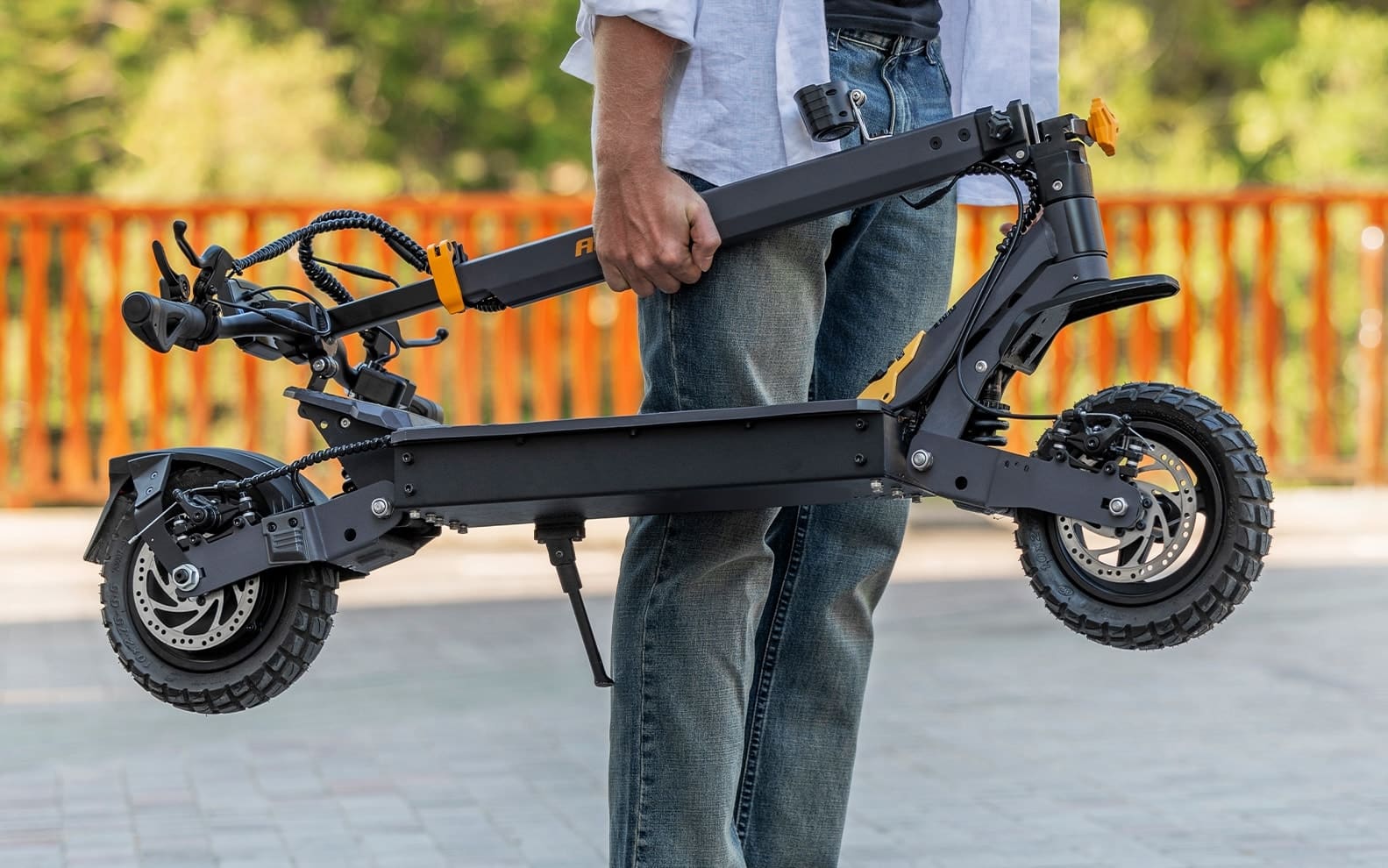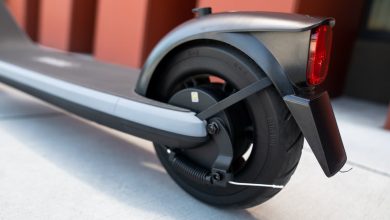Ausom L1 vs. Ausom DT2 Pro: Real-World Comparison, Performance Tests, and Which Scooter You Should Buy
Electric scooter shoppers often face a familiar dilemma: should you save money and get a reliable commuter scooter, or pay extra for top-tier performance? To answer that question honestly, we ran two of Ausom’s most talked-about scooters through a full series of real-world tests: the Ausom L1, priced at $599, and the brand’s flagship, the Ausom DT2 Pro, coming in at $1,149.
On paper, the DT2 Pro should dominate. It has dual motors, higher voltage, and a much bigger battery. But during testing, the results were more surprising than expected. If you’re trying to decide which scooter fits your daily commute, weight, speed expectations, or terrain, this breakdown will help you choose with confidence.
Table of Contents
Overview: Two Scooters Built for Different Riders
The Ausom L1 is designed for budget-minded commuters who want comfort, adjustability, and clean build quality without spending over a thousand dollars. The DT2 Pro is built for power riders who need highway-adjacent speeds, stronger brakes, and the stability required for riding in traffic.
Here’s how the two compare on core specs:
Ausom L1 Key Specs
- 800 W motor (peak 1,000 W)
- Top speed: 28 mph
- Tested range: 18 miles
- Battery: 48V, 15.6Ah
- Weight: 52.8 lb
- Mechanical brakes
- Adjustable stem and commuter-friendly kicktail

Ausom L1
Choose the L1 if you:
- Need a realistic top speed around 25–28 mph, Ride mainly in bike lanes and urban paths, Want a lighter, easier-to-carry scooter
- Prefer adjustable handlebars and a comfortable kicktail
- Want strong build quality without a high price
Ausom DT2 Pro Key Specs
- Dual 1100 W motors (peak ~2900 W)
- Top speed: 42 mph (real-world sustainable ~35 mph)
- Tested range: 25 miles
- Battery: 52V, 23.4Ah
- Weight: 64.6 lb
- Hydraulic brakes
- Side LEDs, dual charging ports, and upgraded deck grip

Ausom DT2 Pro
Choose the DT2 Pro if you:
- Prefer longer range and brighter headlights, Ride on open streets with traffic, Need hydraulic brakes for real stopping power
- Want strong uphill torque
- Weigh over 200 lb and need stability at speed
Performance Testing: Headlights, Noise, Brakes, Speed, Range, and More
To give shoppers the clearest picture possible, we tested both scooters in controlled and real-world environments. Here’s how they performed.
Headlight Brightness
DT2 Pro: ~20,000 lux
L1: ~1,200 lux
The DT2 Pro’s headlight is significantly brighter and safer for nighttime street riding. The L1’s light is usable for slower commuting but far dimmer. Both allow for easy aftermarket upgrades.
Weight and Portability
- L1: 52.8 lb
- DT2 Pro: 64.6 lb
Both scooters use the same twist-lock folding mechanism, which feels extremely secure. The L1, though, is easier to lift, carry, and store.
Motor Noise Levels
Measured from one foot away:
- L1: 63 dB
- DT2 Pro: 62 dB
Despite having dual motors, the DT2 Pro is slightly quieter. Both scooters are impressively silent for their performance class.
Brakes: Mechanical vs. Hydraulic
This is one of the strongest dividing factors between the two:
- DT2 Pro: Hydraulic brakes with strong bite and smooth modulation. Very little lever force needed. Ideal for high-speed or heavy riders.
- L1: Surprisingly excellent mechanical brakes. Tuned well, snappy, and far better than typical mechanical systems. While not hydraulic, they perform at the top of their category.
If you ride among cars or plan to go above 25 mph, the DT2 Pro’s brakes are a major safety advantage.
Suspension and Ride Comfort
Both scooters use similar spring-only suspension without damping. The ride is plush and comfortable, especially under 25 mph. At higher speeds, the DT2 Pro feels more stable thanks to its heavier frame and geometry.
Deck and Kicktail Design
- L1 Kicktail: Shallow angle, extremely comfortable for weight distribution, meaningfully extends the usable deck. Ideal for commuting.
- DT2 Pro Kicktail: Steeper and harder to use for bracing. It looks aggressive but doesn’t add much practical deck space.
The L1 wins in overall ergonomics for daily riding.
Acceleration and Top Speed
DT2 Pro Speed Results
- 0–10 mph: 1.88 s
- 0–20 mph: 4.31 s
- 0–30 mph: 8.46 s
- Sustainable real-world top speed: ~35 mph
- Uphill speed: ~30 mph
Although the speedometer can read 40+, true GPS-verified speeds are a bit lower. Still, it’s a powerful, fast scooter with excellent stability.

Ausom DT2 Pro
Choose the DT2 Pro if you:
- Prefer longer range and brighter headlights, Ride on open streets with traffic, Need hydraulic brakes for real stopping power
- Want strong uphill torque
- Weigh over 200 lb and need stability at speed
Ausom L1 Speed Results
- 0–10 mph: 4.23 s
- 0–20 mph: 17.23 s
- Real-world top speed: 27–29 mph in slight declines
- Uphill speed: 12–14 mph

Ausom L1
Choose the L1 if you:
- Need a realistic top speed around 25–28 mph, Ride mainly in bike lanes and urban paths, Want a lighter, easier-to-carry scooter
- Prefer adjustable handlebars and a comfortable kicktail
- Want strong build quality without a high price
The L1 behaves exactly as a high-quality budget scooter should. Predictable acceleration and sufficient power for comfortable commuting.
Range Tests
All range tests were performed with a 215-lb rider at top speed.
- DT2 Pro Range: 25 miles
- L1 Range: 18 miles
The L1 achieves around 70 percent of the DT2 Pro’s range, which aligns neatly with its smaller battery size. Both scooters maintain power through nearly the entire discharge curve with minimal voltage sag.
Handling, Stability, and Ride Feel
Both scooters excel in low-speed maneuverability. They lean naturally, corner well, and inspire confidence in bike-lane environments. The shared wing-style handlebar is one of the most comfortable in the class.
Ride feel differences:
- DT2 Pro: Extremely stable at 25–30 mph. One-handed riding is possible and safe.
- L1: Stable at its top speed, but requires two hands at all times, which is expected for a lightweight commuter scooter.
Who Each Scooter Is Best For
Ausom L1: Best for Budget Commuters
Choose the L1 if you:
- Ride mainly in bike lanes and urban paths
- Want a lighter, easier-to-carry scooter
- Prefer adjustable handlebars and a comfortable kicktail
- Want strong build quality without a high price
- Need a realistic top speed around 25–28 mph
It’s one of the most well-rounded scooters available under $600.
Ausom DT2 Pro: Best for Power and Heavier Riders
Choose the DT2 Pro if you:
- Ride on open streets with traffic
- Need hydraulic brakes for real stopping power
- Want strong uphill torque
- Weigh over 200 lb and need stability at speed
- Prefer longer range and brighter headlights
The DT2 Pro is a meaningful upgrade for anyone who needs performance beyond typical commuter speeds.
Final Verdict: Which Should You Buy?
For everyday commuting, portability, and comfort, the Ausom L1 is the scooter I’d personally choose. It’s lighter, easier to manage, and built extremely well for the price.
For riders who need to blend into traffic, climb steep hills, or ride at higher speeds, the Ausom DT2 Pro is the obvious choice. It delivers the braking power, acceleration, and stability required for road riding.
Both share Ausom’s excellent build quality, secure folding system, clean cable management, reliable NFC dashboard, and smooth acceleration curve.
Your choice ultimately comes down to your riding environment and what you value most: comfortable commuting or performance power.
Not the scooter for you? Check out our database full of scooters.




